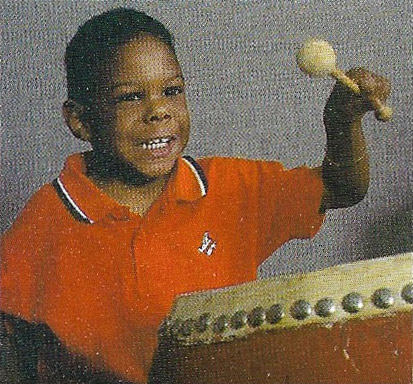music therapy

Figue 1. The Old Testament relates how a David played the harp to King Saul when he was possessed by an evil spirit, and "the spirit departed from him".

Figure 2. Children with learning difficulties – even those who are unable to speak – can be encouraged to develop communication skills by responding to music and interacting with the music therapist.

Figure 3. Playing the drums can provoke the release of exuberant emotions. This can provoke the release of exuberant emotions. Music therapy can be particularly effective with children, whose reactions to music are often spontaneous and uninhibited.
The link between music and healing is an ancient one, but it is only since the 1940s that music therapy has developed in the West as a way of helping those with serious disabilities, mental illness, or psychological distress. Making or responding to music can provide a real alternative to verbal communication, enabling the expression of emotions that may be too profound or primitive for words. Within both complementary and conventional medicine worldwide, particularly intensive care units and delivery rooms, patients are encouraged to listen to music to ease anxiety and pain, and to promote recovery.
Ancient use
Music has long been used to stir emotions, and there are accounts of the healing power of music in the Bible and Homer's Odyssey. The modern practice of music therapy developed in the US at the end of World War II, in response to the psychological distress of returning war veterans. Success in their treatment led medical authorities to employ musicians in hospitals, and the National Association of Music Therapy was established in the US in 1950.
In 1958, UK concert cellist Juliette Alvin, renowned for pioneering work among children with learning difficulties, formed the British Society for Music Therapy. In 1974, US concert pianist Paul Nordoff and UK special education teacher Clive Robbins, known for their work with autistic and emotionally disturbed children, started their first training course in London. There are about 300 qualified music therapists in the UK, many of them working within the National Health Service, compared with 7,000 in the US and 300 in Australia.
Consulting a practitioner
Treatment takes place on a one-to-one or group basis, and patients range from those seeking help for emotional problems to physically or mentally disabled people. Sessions usually last an hour and the length of treatment will vary according to your condition. The aim of therapy is to help you release tension and deal with problems more effectively by expressing emotions in a non-verbal way and building a trusting relationship with the practitioner or other group members.
A session usually starts with the practitioner playing a tune or singing a song. As your confidence grows, you will be encouraged to respond, improvising on percussion instruments or with your voice. You will not be taught to play any instruments, and musical knowledge is unnecessary. Eventually, you may be able to express feeling in new ways.
For stress-related conditions and pain relief, the practitioner may ask you to select a piece of music to listen to that you find soothing. With elderly and terminally ill patients, this can stimulate memories, a therapeutic effect in itself. The rhythm of music is also said to affect physiological processes, such as heart-rate or breathing, and prompt the release of endorphins, the body's own painkillers.
Evidence and research
Worldwide research is taking place into the effects of music on the immune system. Studies in the US, the UK, and Germany, published in 1991, showed that patients who listened to music recovered more quickly than average and felt less anxiety and discomfort. Some studies in the 1980s and 1990s, such as those by Ralph Spintge in Germany, suggested that music with a certain rhythm reduce stress by lowering the heart-rate, blood pressure and respiration. Research in Europe, the US and Australia in the 1980s confirmed that music therapy can benefit those with physical and mental disabilities.
Medical opinion
Doctors acknowledge that music therapy can help patients release emotions and relax, and it may have a useful part to play in the care of mentally and physically disabled people. Such patients are increasingly referred to music therapists, although most doctors are not convinced of music's ability to treat illness by affecting body systems directly.


